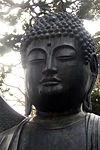
Back حداثة بوذية Arabic বৌদ্ধ আধুনিকতাবাদ Assamese Buddhistischer Modernismus German Néo-bouddhisme French Buddhista modernizmus Hungarian Modernisme Buddhis ID Необуддизм Russian Буддійський модернізм Ukrainian Neobuddizm Uzbek Phật giáo hiện đại Vietnamese
| Part of a series on |
| Western Buddhism |
|---|
 |
| Part of a series on |
| Buddhism |
|---|
 |
Buddhist modernism (also referred to as modern Buddhism,[1] modernist Buddhism,[2] Neo-Buddhism,[3] and Protestant Buddhism[4]) are new movements based on modern era reinterpretations of Buddhism.[5][6][7] David McMahan states that modernism in Buddhism is similar to those found in other religions. The sources of influences have variously been an engagement of Buddhist communities and teachers with the new cultures and methodologies such as "Western monotheism; rationalism and scientific naturalism; and Romantic expressivism".[8] The influence of monotheism has been the internalization of Buddhist gods to make it acceptable in modern Western society,[9] while scientific naturalism and romanticism has influenced the emphasis on current life, empirical defense, reason, psychological and health benefits.[10]
The Neo-Buddhism movements differ in their doctrines and practices from the historical, mainstream Theravada, Mahayana and Vajrayana Buddhist traditions. A co-creation of Western Orientalists and reform-minded Asian Buddhists, Buddhist modernism has been a reformulation of Buddhist concepts that has de-emphasized traditional Buddhist doctrines, cosmology, rituals, monasticism, clerical hierarchy and icon worship.[11] The term came into vogue during the colonial and post-colonial era studies of Asian religions, and is found in sources such as Louis de La Vallée-Poussin's 1910 article.[12]
Examples of Buddhist modernism movements and traditions include Humanistic Buddhism, Secular Buddhism, Engaged Buddhism, Navayana, the Japanese-initiated new lay organizations of Nichiren Buddhism such as Soka Gakkai, Girō Seno’o’s Youth League for Revitalizing Buddhism, the Dobokai movement and its descendants such as Oneness Buddhism, Sanbo Kyodan and the missionary activity of Zen masters in the United States, the New Kadampa Tradition and the missionary activity of Tibetan Buddhist masters in the West (leading the quickly growing Buddhist movement in France), the Vipassana Movement, the Triratna Buddhist Community, Dharma Drum Mountain, Fo Guang Shan, Won Buddhism, the Great Western Vehicle, Tzu Chi, and Juniper Foundation.
- ^ Lopez 2002, p. 10.
- ^ Prebish/Baumann, 2002
- ^ H. L. Seneviratne (1999). The Work of Kings. University of Chicago Press. pp. 25–27. ISBN 978-0-226-74866-5.
- ^ McMahan, David L. (March 30, 2015). "Buddhist Modernism". Oxford Bibliographies. Retrieved 2024-10-13.
- ^ McMahan 2008, pp. 5–7, 32–33, 43–52.
- ^ Cite error: The named reference
gowans91was invoked but never defined (see the help page). - ^ Cite error: The named reference
lopez39was invoked but never defined (see the help page). - ^ McMahan 2008, pp. 6–10.
- ^ McMahan 2008, pp. 54.
- ^ McMahan 2008, pp. 63–68, 85–99, 114–116, 177, 250–251.
- ^ Cite error: The named reference
mcmahanoup1was invoked but never defined (see the help page). - ^ de la Vallee Poussin, Louis (1910). "VI. Buddhist Notes: Vedanta and Buddhism". Journal of the Royal Asiatic Society of Great Britain & Ireland. 42 (1). Cambridge University Press: 129–140. doi:10.1017/s0035869x00081697., Quote: "A historical study of Neo-Buddhism would be very interesting, as an episode of the intellectual conquest of the East by the West and vice versa."